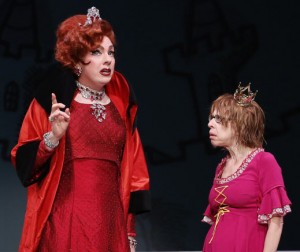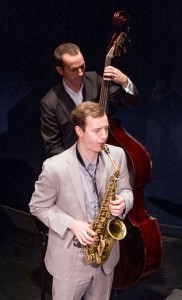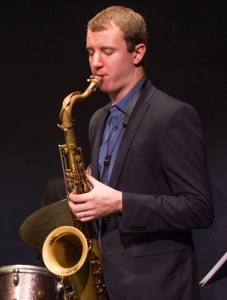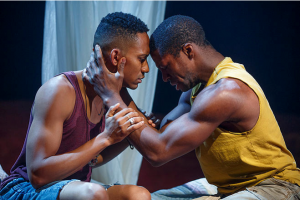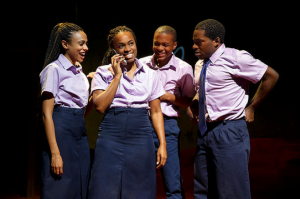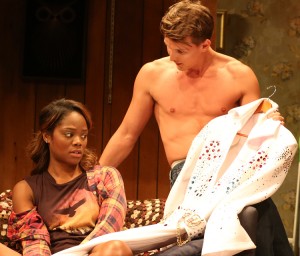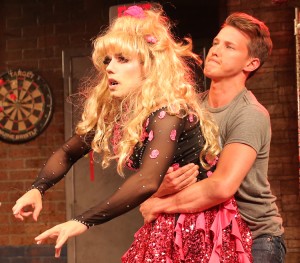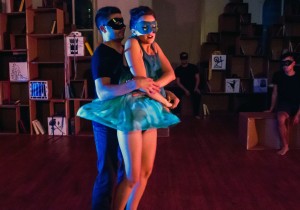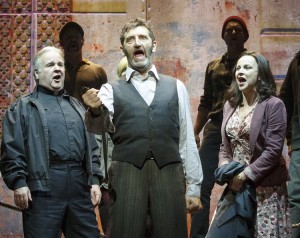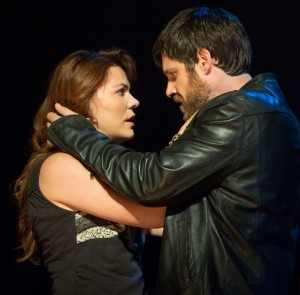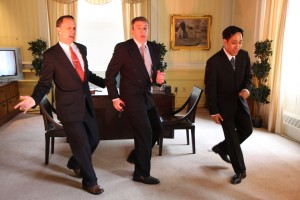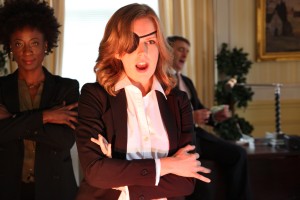The Golden Bride ("Di Goldene Kale"), a joyful operetta from 1923 performed on the compact stage at the Museum of Jewish Heritage by the National Yiddish Theatre Folksbiene, is set in a small Russian village and begins with a tongue-in-cheek song about money. In Yiddish with English and Russian supertitles, the cast sings “Oi, Oi, The Dollar” when Goldele, a young woman who has been raised by another family learns that her father, who moved to America when she was a child, has died and left her a fortune. Thus begins a tale that folds real-world politics (the metamorphosing face of Russia, immigration and the pursuit of money in America) into a fairytale of love and marriage.
Sleep-Deprived Shenanigans
Noble Jazz Masters
The Anderson twins, Peter and Will, are back with a new show at 59E59 Theaters, where two Decembers ago they brought Le Jazz Hot: How the French Saved Jazz, a revue about the attraction of Paris for jazz musicians; that show earned them a Drama Desk nomination. Their new creation, The Count Meets the Duke, has a narrower focus—the lives of jazz titans Count Basie and Duke Ellington—and it is more of a straightforward tribute. Created and directed by the brothers, it’s not only an evening of superb musicianship but as informative as their earlier works, which include The Anderson Twins Play the Fabulous Dorseys.
Subtitled The Anderson Twins Play Basie and Ellington, the show focuses on Count Basie in the first half, with Will narrating; Pete takes up the honors later for Ellington. There’s some crossover—both jazzmen had great respect for each other and even played together. The twins have been typically rigorous in digging up rare interviews and stills to be projected behind them, so there’s a clip of Basie praising Ellington, for instance. Also hanging on the walls are several drawings of the subjects by the late New York Times illustrator Al Hirschfeld, himself a jazz enthusiast.
As hosts, Will, who plays alto saxophone, clarinet, and flute, and Pete, who is on tenor saxophone and clarinet, lack the polish of trained actors, but their unassuming charm hits the right note for the intimate setting, and their passion is infectious. Even if one isn’t a jazz aficionado, their recitation of players whose names mean nothing to a listener makes it clear that the people who own the names are important in their field. Although, as Will notes, Thelonius Monk once said, “Talking about music is like dancing about architecture,” the brothers manage to impart a good deal of fascinating information and draw one into their musical orbit.
There are plenty of jazz milestones mentioned: Duke Ellington’s appearance at the 1956 Newport Jazz Festival, when tenor saxophonist Paul Gonsalves played 27 choruses (six or seven was the usual number), a woman jumped on stage and discarded an article of clothing for each chorus, and a riot nearly ensued. There’s the story of Basie’s upbringing: born in Red Bank, N.J., he played piano for silent films and in bars as a teenager. Later he took to the road, finding musical work with traveling burlesque shows. Finding himself in Kansas City in the 1930s—a mecca for the best jazz in the country—he buffaloed bandleader Bennie Moten, a pianist, into believing that in New York it was all the rage to have a second piano, and he got himself hired for the job.
There are film clips such as Count Basie’s bizarre appearance with his band in the middle of the desert in Mel Brooks’s Blazing Saddles (1974), and Ellington alongside James Stewart in Otto Preminger’s Anatomy of a Murder in 1959, as well as his guest shot on What’s My Line in 1953. Or the Duke waxing humorous on rhythm: “One never snaps one’s fingers on the beat—it’s considered aggressive.” There’s even a rare clip of Billy Strayhorn at the piano; his orchestrations greatly enhanced Ellington’s compositions.
All that, however, is just the background to the main event: the playing. The show features Jeb Patton on a Steinway, Clovis Nicolas on bass and Phil Stewart on drums. Whether on swing numbers like Lester Young’s “Tickle Toe,” written for Basie, and Ellington’s “Main Stem,” or on slower, more languid ones like Neal Hefti’s “Li’l Darlin,” written for Basie, and Ellington’s “The Star-Crossed Lovers,” an excerpt of a 1957 album in which the Duke focused on Shakespeare’s plays, the five-man combo is terrific. Along the way, every performer gets to shine. Pete has a solo on the clarinet in “Ad Lib on Nippon,” in which Patton has a fine solo too. Patton also performs a piano version of “Corner Pocket,” written by Freddie Green for Basie’s orchestra. There’s even a holiday excerpt from Ellington and Strayhorn’s version of Nutcracker Suite called “Sugar Rum Cherry”—a jazzy version of you-know-what.
If you’re looking for high-quality musicianship skillfully interwoven with intellectual enlightenment for the holidays, then bop over to The Count Meets the Duke.
The jazz revue The Count Meets the Duke runs through Jan. 3 at 59E59 Theaters (59 E. 59th St. between Park and Madison Aves.) in Manhattan. Tickets are $25 through Dec. 20; $35 starting on Dec. 22. Evening performances are at 7:30 p.m. Tuesday-Thursday and Sunday, and at 5:30 and 8:30 p.m. on Friday and Saturday. Matinee performances are at 2:30 p.m. on Saturday and 3:30 p.m. on Sunday. For tickets, call Ticket Central at 212-279-4200 or visit 59E59.org.
Uganda Comes to New York City
In 2005, Griffin Matthews made the nearly 7,000-mile journey from the skyscrapers of New York City to the hills of Uganda to become one of the many American volunteers looking to “find themselves” and “change the world” by building schools in Africa. Now, Matthews stars in a musical about his journey and in doing so, brings the lives of those in Uganda to a New York City stage. Sound a little cliché? Perhaps it is, but Invisible Thread is a feel-good story brought to life by a clever script, catchy score, uplifting message and talented cast.
Co-written by Griffin Matthews and real-life partner/composer Matt Gould, Invisible Thread began as a piece titled Witness Uganda which won the Richard Rodgers Award for Musical Theater in 2014. Griffin was a struggling actor booted from his church’s choir for being gay when he made the decision to leave his boyfriend Ryan (Corey Mach) behind to sign on as a volunteer. Instead of simply extolling this decision, Invisible Thread calls into question the reason that people perform altruistic deeds in the first place. Is it to help others or to help ourselves feel good? And does the motivation really matter if there is good coming from it?
Through self-deprecating humor and witty lines, both Ryan and Griffin acknowledge their somewhat stereotypical problems. “Imagine, a gay in the tenor section!” Upon arriving in Uganda at the compound where he will be building a school, Griffin meets a woman who is ironically named Joy (Adeola Role). She has built up a wall to protect herself from the constant stream of volunteers who she has learned she will never see again despite their promises. Griffin also meets Jacob (Michael Luwoye), Joy’s brother who works at the compound. They quickly form a bond and Jacob reveals what is really going on with all the schools the volunteers are building. Pastor Jim, who we never meet, immediately sells them for a profit once the volunteers leave.
Looking for answers, Griffin follows Jacob to the market, where he encounters and befriends four teenage orphans—Ronny (Tyrone Davis, Jr.), Grace (Kristolyn Lloyd), Eden (Nicolette Robinson) and Ibrahim (Jamar Williams). Discouraged by the news that his volunteer efforts with the school will result in no real change, Griffin decides that he will instead teach these four teens and Jacob in an abandoned library. As things progress, Griffin realizes that he may be in over his head. His relationships with the students and his determination to make a difference strengthen despite the obstacles.
Throughout the musical, contemporary songs mix with ones of a more Sub-Saharan styling but all are catchy and moving. The choreography by Sergio Trujillo and Darrell Grand Moultrie complements the music wonderfully and adds an energy and power to the performance that is further enhanced by stunning, soulful vocals from the ensemble. A dirt stage is slightly mismatched with the two projection screens, calling attention to the differences between New York City and Uganda.
Diane Paulus directs a talented cast with Role delivering a standout performance as Joy. Mach does what he can with the role of Ryan, though the character seems somewhat less developed than it could be and appears to be an evolving piece in the script based on previous iterations of the production. The climax in the second act seems somewhat muddled, though everything comes together in the end, perhaps too perfectly to properly portray the complicated topics addressed. Invisible Thread is a production which is clearly a result of passion and purpose but it manages to avoid becoming preachy or self-promotional.
Invisible Thread is playing at Second Stage Theater (305 West 43rd St. between 8th and 9th Aves.) through December 27. Tickets range from $69-$125 and can be purchased by calling 212-246-4422 or visiting www.2st.com.
Getting Down and Dirty
Over the years, musical theater has certainly seen its fair share of romantic comedies—from 1970's Company to 2011's First Date—the concept of young people finding love onstage seems almost as ancient and time-honored a ritual as love itself. However, none seem to match the irreverent and brashy style of Level II Theatre's Love is Like Mud. Presented as part of the 2015 New York International Fringe Festival, at intimate downtown venue Drom, Mud sets itself apart as a delightful, fizzy romantic comedy "cocktail"—heavy on the comedy.
At the show's open, we meet lovelorn Jon (Gavin Rohrer), as he, following a recent breakup, laments to his parents about the merits of love. In an attempt to comfort his son, Marshal (Jay Liebowitz) memorably dispenses this piece of wisdom: "It's pliable, dirty. Love isn't like a diamond. It's more like...mud." With this thought in mind, Jon enters once more into the breach, braving the city streets alone in search of that messy thing called love—until, like a clod of dirt in the face, it finds him. In what could only be described as a "Missed Connections" advertisement come to life and set to music, Jon meets Anne (Taylor Kate Manns) after recognizing her from their regular commute home ("Same Spot Again"). He asks her out, and after the success of their first date ("Excellent Choice"), they embark on a relationship together. For a while, all is well and at the height of their time together, even Jon's parents get in on the act, prodding them about taking that "next step" in their relationship ("Grandkids").
Soon afterward, the "honeymoon goggles" come off and their seemingly-blissful phase starts to wane. In a complete turnaround, Anne begins to recount Jon's faults ("The Little Things") and Jon, for his part, soon develops that ever-dreaded roving eye ("Wanderlust"). The two eventually part ways, and at the instruction of their friends, drunken metal-head Angelo and yoga health-nut Maya (also played by Liebowitz and Elise Raynard, respectively), try playing the field ("Revolving Doors"). But as the saying goes, absence makes the heart grow fonder, and after bumping into one another at a farmer's market, Jon and Anna both realize that they're only stronger together ("Other Girls [The Only One Ever]").
As far as romantic comedies go, Mud doesn't stray too far from the pack, plot-wise. However, its clever coupling of onstage antics—particularly those concerning plush genitalia—and campy song lyrics provide a much-needed offbeat kick. Writer-director Benjamin Folstein's band, Level II, lends much of Mud's comedic flair through its catalog of original songs, which references influences from jazz to 90s pop-rock. Both lyrically and structurally, the songs do not follow the traditional musical theater format, presenting a unique take on the genre that is ultimately much fresher than the show's "dirty" name implies.
It is the aforementioned performances of the actors, however, which certainly add the "oomph" to the music's kick. As the two twenty-somethings at the center of the show, Rohrer and Manns demonstrate great chemistry with one another, both vocally and physically. The latter's solo performance in the middle of the show ("There You Are")—reminiscent of Karessa's solo in Jonathan Larson's Tick, Tick... Boom!, another off-Broadway hit— definitely brought the house down. For their part, Liebowitz and Raynard are the perfect foils to the more even-tempered lead duo, providing much of the show's comedic relief.
Love is patient, love is kind; but what they never tell you is that it's also kind of a hot mess. Folstein and Level II Theatre's Love is Like Mud gets down to the nitty-gritty of it all, while also gettin' down to some good, ol' fashioned rock 'n' roll. The music may not always feature pretty little love songs, but they still get to the heart of the matter. That is, after all, what love's about.
Level II Theatre's production of Love is Like Mud ran at the DROM (85 Avenue A between 5th and 6th Street) in Manhattan from August 15-29 at the New York International Fringe Festival. For more information about this production, visit www.loveislikemud.com.
Dressed to Cross
Matthew Lopez, best known for The Whipping Boy, an intense drama about slavery and the Civil War, could hardly have followed it with something more different than The Legend of Georgia McBride, a confection of spangles and sass at the Lucille Lortel Theatre. The new play is a farce in the vein of La Cage aux Folles and Tootsie, leavened with some obvious sermonizing about finding one’s inner self and celebrating the indomitability required to wear a dress and padding—sort of “Climb ev’ry mountain, find ev’ry frock.” It’s good fun, and there are plenty of laughs, but it’s also predictable. Uptown, for instance, an empowered drag queen saves a whole factory full of straight people by manufacturing irrepressible footwear.
Skillfully structured by Lopez, and well-directed by Mike Donahue for MCC Theater, Georgia McBride follows a young married man, Casey (Dave Thomas Brown), who can’t manage to support his wife, Jo (Afton Williamson), by performing as Elvis. When they’re about to be evicted from their home because they’re behind on their rent, and Jo is pregnant, the irresponsible Casey reassures Jo with “We’ll figure it out."
Under Tracy’s tutelage, Georgia starts as an ugly duckling but becomes a star. In typical farce fashion, however, Casey doesn’t tell his Jo what he’s up to. He just hands her the increased income and explains that bookings of heavy metal bands have increased profits at the bar, which is 40 miles from their home. Eventually, of course, Jo finds out everything, and there’s some dramatic hand-wringing about whether she will leave him, but none of it rings true, and Williamson in the thankless role can’t do much to invest it with suspense.
The cast is mostly outstanding. Nobbs plays two roles, and as Rexy he’s not really convincing as a woman, unless you think “roller derby.” (The idea that Rexy could pull off Piaf is ludicrous.) But as Casey’s henpecked neighbor Jason, the actor shows why he’s one of his generation’s outstanding artists. A highlight of the production is Jason’s recollection of his dating “a gender nonconformist” that Nobbs imbues with nostalgia, rue and gentle humor.
McGrath as Tracy has the showiest role, and he seizes it with relish, by turns sympathetic, caustic, disdainful, but most often indomitable. He has the fun of dropping most of the inside references: to Stephen Sondheim (Company, Sweeney Todd and West Side Story), What Ever Happened to Baby Jane?, and Auntie Mame, among many others.
Anita Yavich supplies all the explosions of color one expects from drag costumes—and there are plenty of them—and Ben Stanton’s lighting is sometimes subdued, sometimes garish, and always fun. Donyale Werle has contributed a set that screams “sleazy white trash.” (It’s a stereotype that Lopez indulges in as well, when Jason speaks of his wife and children: “There were rumors we had some cousins in common, and now I think that might have been true.”)
All in all, The Legend of Georgia McBride covers well-tilled ground, but has enough wit and wisdom of its own to make a visit pleasurable.
The MCC Theater production of The Legend of Georgia McBride runs at the Lucille Lortel Theatre (121 Christopher St. between Bleecker and Hudson Sts.) in Manhattan through Oct. 11. Evening performances are at 7 p.m. on Tuesday and Wednesday, and 8 p.m. on Friday and Saturday, with Thursday evening performances at 7 p.m. on Oct. 1, and at 8 p.m. on Sept. 24 and Oct. 8. Tickets may be purchased by calling 212-727-7722 or visiting www.mcctheater.org.
Girls! Girls! Girls!
Occluded by a flashy, tourist-ridden diner on 42nd Street, the decaying splendor of the old Liberty Theater provides the perfect bootleg venue for Midnight Frolic, the third interactive show in the Speakeasy Dollhouse series by author, artist and playwright Cynthia von Buhler. The sparkling acrobatic, musical, and dance numbers stand out in this production as palimpsests of the indulgent variety shows of Florenz Ziegfeld's heyday in New York City; however, though from the beginning Midnight Frolic promises interactivity and immersion, it is far too busy being a vaudeville show to enfold audience participants into its world.
All That Jazz
For many Americans, the height of the Jazz Age undoubtedly reached its apex in the Roaring Twenties; particularly, when the Harlem Renaissance had both black and white night owls of the country flocking to the neighborhood's mysterious speakeasies and smoky basement-level dens for some of the best live music New York City had to offer. However, for playwright John Attanas, the very new, percussive sounds of jazz was only just beginning to find its groove, as the country moved into the early 1950s. Such is the world of Attana's newest work, All Gone West.
Set in post-war New York City, we meet Sam Samos (Joseph Robinson), a young and handsome war vet who learns about the fast-paced rhythms of the city—and of course jazz—from his fellow vet and black saxophone player Sonny Green (Jesse Means). Not long after settling in the city, Sam finds himself falling for Mary (Kristen French), a beautiful secretary at City College, whom he encounters one night when she walks into his bar with an older man, Joe (Glen Williamson), a professor at the college with alcoholic tendencies. They hit it off, and after Sam's persistence, Mary gives in and they begin a courtship, leaving Joe to his own devices.
The two lovebirds eventually marry despite their clear differences: Sam, an idealistic modern, is intent on one day opening his own jazz club, while Mary leans towards the conventional, with no high ambitions and generally happy with the lot she is given. These differences start to strain their marriage as Sam finally makes his dream come true, with the help of his friend Willie (Anthony Bosco), a fellow gambler whose questionable connections provides Sam's dream the financial help it needs. His club—christened The Blind Spot—starts off smoothly enough until Sam has trouble booking jazz acts that would draw crowds. He looks to Sonny, who by now has been approached with a record deal, but also has been nursing a drug addiction. As the bills start piling up, Sam desperately attempts to get by with some further help from Willie, as well as the hire of a prostitute (Kristen Booth). Ultimately, their business folds, and the two decide to follow the national pilgrimage West, where better—if only practical—prospects lay ahead.
Told in a magical realist-style, with the two lovers narrating between scenes, West's mood is evocative of the film noir genre that was popular during that era, and particularly called to mind films like Sweet Smell of Success and The Big Sleep. Just as the genre plays with contrasts, so does the thematic through-line of the play itself: the conventional versus the unconventional, new versus old. This is reflective not only in the fact that jazz inherently defies convention, but also in the differences between the characters—in particular, that of the ambitious Sam, and the content Mary. In their respective leading roles, both Robinson and French seem plucked straight out of the period. From the way Robinson's cool vibe to French's spot-on "New Yawk" accent, they embody stars of a bygone era. Cementing these solid performances were the supporting cast. Means' Sonny is confident and cool, yet belies a vulnerability. Another vulnerable portrayal was that of Williamson, whose alcoholic Joe displayed his weaknesses from the very beginning. Both characters each succumbed to their addictions, but their respective arcs are buoyed by the performances of both actors. Finally, Booth, whom perhaps had the most difficult task of the night, portraying multiple characters, also proved to be another strong presence onstage.
Also vital in setting the overall mood of the play was the presentation itself: the set designed by Andrew Diaz was naturally minimal in the modest performance space. Despite these limitations, the audience was nevertheless transported in time. Furnished by a simple brick wall structure, plastered onto which are various vintage posters, featuring advertisements for department store Gimbels and the Aqueduct racetrack. The use of various props—which include a dining table set and other pieces such as vintage glass soda bottles, newspapers and telephones—also help in differentiating between locales and situations. Nicholas Staigerwald's costumes added another dimension dressing the actors in various sartorial styles that were typically in vogue at the time, and worthy of any Modcloth shopper's envy today—particularly, a monochrome polka-dot one-piece bathing suit Mary dons towards the end. Of course, the element that perhaps had the most impact was the live jazz band, which brought to life the era in which the characters lived, and provided a romping soundtrack to the story.
A play about all kinds of losses—from the old to the new; the death of New York and the rise of the East Coast—All Gone West is certainly anything but your average show.
All Gone West ran from March 28 to April 18 at Teatro Circulo (64 East 4th St. between 2nd Ave. and Bowery). For more information on this production, visit the show's website: http://allgonewest.org/.
Whose Lyric Is It, Anyway?
Back when I was in high school, my cousin and I made up an impromptu jazz-age musical called Loser: The Musical, wherein a lowly, poor broom boy (based on a broom boy at the local Dunkin' Donuts whom my cousin and her sister insisted I had a crush on — don't ask) falls in love with a rich girl he stumbles upon one day. As one could expect, there were cheesy numbers galore, with inclusion — of course — of the musical's title theme, "Loser," which our hero would sing forlornly as the rich girl drove away with her Also-Rich-But-Also-A-Jerk fiance.
Unmasking the Fables
After reading the tales of Snow White, Thumbelina, Sleeping Beauty, or Belle, have you ever felt that something was missing? With the lyrics of Nick Luckenbaugh, director and choreographer Megan Mekjian uses the musical Royal Fables to fill in the gaps of these familiar fairy tales.
The musical begins with Scheherazade (Livie Castro), a young bride from One Thousand and One Nights, who sings her song about the murderous king and how she must sing a different song each night in order to persuade the king not to kill her on their wedding night. From this song, she introduces and guides the audience through the tales of female protagonists from various fairy tales — each singing a song that relates to their own fable. The twist is that these songs have never been heard, and each song reveals an inner thought these women have never shared with anyone else before.
Although a cleaver plot, Royal Fables' creative story line is confusing to the audience members who haven't read the program prior to the show. With no dialogue, the audience is only left with the lyrics of the songs as they sort out the characters and plot. Although some of the women could not be heard over the three-person band (Ansel Cohen, Jimmy Lopez and Mike McGuckin), there were a few subtle hints that could be found within the technical aspects of the show such as the set and costumes.
Set on the wooden floors of a large room, the cardboard box inspired set added a child-like feel to the environment. The homemade bookcases added depth to the stage and created a convenient backstage for the actors. The images on the bookcases matched the images in the program and allowed the audience to figure out which fables would be included in the show.
The short, whimsical-styled costumes left us with little to no clues at which fable the women came from, but instead created a loosely uniformed look for the princesses and allowed them to freely perform their choreographed routines. As stated in the libretto, each princess wore a mask until it was their time to sing their own song. In this sense, the masks became a symbol of taking off their guise to reveal their own truths. However, yet again, there wasn't an obvious distinguishing design on the masks to help the audience identify which female character was singing the song.
With a cast of 18 actors, Royal Fables' contained plenty of raw talent. The cast's dedication to the show was obvious in their flawless execution. Without the actors’ mesmerizing performances, the play would have fallen flat, especially since the musical had no clear climax. Although the songs were beautifully sung, there was no build in the plot and nothing to propel the story besides the actors’ high energy.
Royal Fables ran until Nov. 15 at the Access Theater (380 Broadway between Walker and White Sts.). For more information, visit www.libratheater.org.
R&H Hit the Avant-Garde
When it first appeared in 1947, Allegro was clearly a departure from Rodgers and Hammerstein’s earlier shows, Oklahoma! (1943) and Carousel (1945). Influenced by Thornton Wilder’s classic, Our Town (1938), Rodgers and Hammerstein intended it to be staged experimentally—without scenery and employing a Greek chorus. (Stephen Sondheim, a protégé of Hammerstein, was a gofer on Allegro, and he has attributed his willingness to experiment in his own works to the experience he had on his mentor’s show.) The simple plot—the life of a doctor from birth to age 35—seemed appropriate for a pared-down approach. But the musical flopped.
Still, Allegro is one of those fascinating footnotes that one hopes deserves another chance with the right director. John Doyle, who is at the helm of the current revival at the Classic Stage Company, employs his signature style for it—performers also play the instruments. That fits in nicely with a production that still has the choral commentary and still feels unsettlingly weird coming from the team known for their intensely romantic stories—their next show was South Pacific (1949). Doyle also cuts the show to 90 minutes with no intermission, and it helps.
The show’s major drawbacks remain, however. One is its cinematic quality: it’s a series of snapshots in the life of its hero, Joseph Taylor Jr. It begins with the grown, dressed Claybourne Elder as the infant Joe Jr. sitting next to his mother (Jessica Tyler Wright) with his head on her lap, Pietà-like. Elder manages to capture the innocence of a newborn in the lovely scene. As the book jump-cuts to further episodes in Joe’s life, the chorus comments: Joe learns to walk (in the terrific song “One Foot, Other Foot”), loses his Grandma (an affecting Alma Cuervo) and makes friends in school, notably Jenny Brinker (Elizabeth A. Davis). She is his first love, and eventually she becomes his wife, but Jenny’s father is rich, and he wants her to marry someone with a moneyed future. Though Joe idolizes Joe Sr. (Malcolm Gets) and his small-town, hands-on practice, Jenny steers Joe toward wealthy patients and the big city (Chicago).
That is the second problem. Elder, good as he is, can’t bring excitement to the meek Joe, who never really seems his own man—he’s manipulated by Jenny and others. As his loyal nurse, Emily (Jane Pfitsch), sings in the show’s best-known song, “The Gentleman Is a Dope.”
When Allegro opened, some critics read it as an attack on the wealthy. Hammerstein, who had also written the book, complained that it was being misunderstood, that it was instead a critique of the distractions of big-city life. But a show with a song titled “Money Isn’t Everything” inevitably lacks nuance. Stephen Sondheim, in his book Finishing the Hat, is savvy about the shortcomings of some of his mentor’s lyrics—notably the redundancy in the title song: “Brisk, lively, merry and bright/Allegro.” (That Hammerstein tendency to hammer away is more obvious in another song, “Ya-ta-ta”: “Broccoli, hogwash, balderdash/Phoney baloney, tripe and trash!”)
Near the end, when Joe protests his boss’s dismissal of a lifelong nurse because she has supported union activism in the hospital, the boss (Randy Redd) pays him no mind: “Ah, my boy, but there’s such a thing as discipline—loyalty! We must do many things we don’t want to do. Duty—we must be good soldiers!” It's an obvious echo of the just-concluded Nuremberg trials, where defendants had used the same excuse for their participation in torture, medical experiments, and mass murder. The blunt-force irony comes off as preachy even now, and it must have registered even more forcefully then. The didacticism of Hammerstein’s book also recalls that of Brecht, and Jane Cox’s lighting draws on German Expressionism with its harshness. Twice the lights go up on the audience for the performers to harangue us.
Still, CSC is to be commended for giving this thorny work another look. Rodgers’s music is lovely, and the actors do a fine job playing their instruments and injecting energy into the show. Doyle has paced it well, and it’s not boring. It’s like catching up with an old friend who’s just passing through—the visit may be pleasant, but the next one can wait awhile.
Evening performances for Rodgers and Hammerstein’s Allegro are Tuesdays through Thursdays at 7 p.m., and Fridays and Saturdays at 8 p.m. Matinees are Saturdays and Sundays at 3 p.m. The musical runs through Dec. 14. Tickets start at $70 and are available at www.classicstage.org or by calling 212-352-3101 or 866-811-4111, or at the box office at 136 East 13th St. (between Third and Fourth Aves.).
This Side of Princeton
If there can be too much of a good thing, the Prospect Theater Company’s production of the musical The Underclassman provides the evidence for it. It’s a reworking of a 2005 effort called The Pursuit of Persephone, by composer and lyricist Peter Mills and book writers Mills and Cara Reichel, that was itself an adaptation of F. Scott Fitzgerald’s first novel, This Side of Paradise. In what is clearly a labor of love on their part, the more favorably titled The Underclassman focuses on the college-age Fitzgerald's time at Princeton and his ill-fated romance with Ginevra King, a nationally desirable Chicago debutante.
The score is crammed with gorgeous melodies. The lyrics are sharp and rhyme as cleanly as those of any classic Broadway lyricist. Christine O'Grady's choreography is deft and appropriate. But the story—lower-class boy meets high-class girl, they fall for each other, then boy loses girl—is ultimately too thin and familiar to sustain a running time of more than two and a half hours (with intermission), even if the hero is a great American novelist, and even if one of his classmates is the future heavyweight literary critic Edmund "Bunny" Wilson (Billy Hepfinger), who can't seem to get Fitzgerald to meet a story deadline. Indeed, if Fitzgerald weren't the protagonist on the stage, one might not find as much patience for the endeavor.
Matt Dengler, a fine singer and actor, embodies Fitzgerald’s youthful energy and élan as well as the budding writer’s self-doubt and class consciousness. Jessica Grové is Ginevra, who flirts and captures the writer’s heart. Her motto is “I have to dance to beat the band.” She’s a charmer, but she’s also superficial and self-indulgent. She wants a husband who’s more than just solvent.
At Princeton, Fitzgerald wrote stories (for Wilson’s magazine) and scripts for the Triangle Club, the theater group. Several of the big numbers are Triangle shows that recall the frivolous musicals and revues of the period from the hands of P.G. Wodehouse and Guy Bolton. But the score includes a range of melodic songs, from the sinister, all-male “Black Ball,“ to the comic love duet “Let’s Don’t.”
The Underclassman introduces many characters, all of them skillfully drawn and well-acted. Piper Goodeve is Ginevra’s lovelorn best friend, Marie Hersey (aka “Bug”), who is carrying a torch for Fitzgerald and who winds up finding solace with the often romantically clueless Wilson. The Triangle Club Boys include the handsome, dashing Trip Everett (Jordan Bondurant), who merits a tragic story line; the director of the group, “Ham” Samuels, played with cheery demeanor and peppy exhortation by Jeremy Morse; and Clive Bagby, (Jason Edward Cook), an eager opportunist who wants more important parts on stage.
Still, the musical doesn’t show Fitzgerald and his rich cronies as people of much depth. He’s a romantic and, in the tired old trope, “playing the game”—although Ginevra is far better at it. Wilson is a typically stolid second banana, and the crossed amours have been seen before. If you look past the glitter, the plot—the game of love turning unexpectedly real; the lovestruck boy reaching for the stars, as it were—is less than fresh.
Perhaps that’s why Marrick Smith, as the devoted John Peale Bishop, Fitzgerald’s roommate, makes such a deep impression. J.P., whose future is poetry, struggles with leaving school and fighting in the war in Europe; he is also, possibly, a bit in love with Fitzgerald. Smith communicates depths of feeling and substance in glances and intonation throughout his performance that make his character more interesting than the main event. He points up the callowness of Fitzgerald, and he steals every scene he’s in.
Wilson finally gets a story from Fitzgerald that he can publish, and his assessment is: “It lacks structure; it lacks focus; it lacks brevity; and yet…the whole preposterous farrago is animated with life.” The Underclassman is in much better shape, though its length is unwieldy. It is splendidly sung and gorgeous to look at, but it needs trimming from a director who is not so attached to the material. The weight of the talent on display is too much for its modest shoulders to bear.
Tickets for The Underclassman are available online at Dukeon42.org or by calling (646) 223-3010. The show runs at the Duke, 229 42nd St., to Nov. 30. Evening performances are at 8 p.m. Thursday through Sunday; at 7:30 p.m. Nov. 24 (a Monday) and 25. There is no evening performance on Nov. 26 or 27. Matinees are at 3 p.m. on Nov. 29, and 30; there is also a 2 p.m. matinee on Tuesday, Nov. 25.
Sentimental Vessel
The Last Ship, the new musical scored by Sting, has arrived on Broadway after a long gestation, including an Off-Broadway concert version at the Public Theater in 2013. The result falls into a niche of shows about the British working class and industrial strife. They include Billy Elliott, in which Margaret Thatcher is excoriated for breaking the miners’ union; A Time for Singing, a nearly forgotten, gloriously melodic 1966 musical about a Welsh miners’ strike that has just closed at the York Theatre; The Full Monty, whose unemployed steelworkers turn to stripping to survive; and The Boat Factory, a Northern Irish two-hander that visited the Brits Off Broadway series in 2013 and focused on a Belfast shipyard that had built the Titanic.
John Logan and Brian Yorkey’s book for The Last Ship mingles working-class lives and hard labor with a light-headed romanticism. The story follows Gideon Fletcher, the son of an autocratic mineworker who expects that Gideon (Collin Kelly-Sordelet plays him as a teenager; Michael Esper, as an adult) will grow up in the same line of work. But Gideon wants to get away from his small town, Wallsend, a suburb of Newcastle-upon-Tyne, in the north of England. Even after his father suffers a stroke and needs him to provide, Gideon plans an exit with his girlfriend Meg (Rachel Tucker). They talk romantic nonsense about becoming stowaways and pirates, but at the last minute she stays behind.
Fifteen years pass, and Gideon (Esper) returns to Wallsend for his father’s funeral, with the intention of settling down with Meg. His expectation that she’ll be ready to resume their love affair is, of course, foolish. She is living with a shipyard worker, Arthur (played with a confident level-headedness by Aaron Lazar), and she has a son, Tom (Kelly-Sordelet again), who is 15, and, even to those flummoxed by math, obviously Gideon’s.
The lyrics (also Sting’s) and book exalt the dignity of the laborers at the boatyard who are unemployed yet insist that the shipyard must reopen. The new owner, however, intends to convert it to handling junk and salvage. “What are we men without a task to complete?” lament the proud shipbuilders, who are scraping by. They scorn the offer of retraining, seize the shipyard, and sing, “Steel in the stockyard, iron in the soul/We’ll conjure up a ship where there used to be a hole/And the ship sets sail, and the tale gets told/And the only life we’ve known is in the shipyard.” Sting was born and raised in the community, and one can feel the truth of the camaraderie and frustration in these lives.
The men plan to build one last ship, one that hasn’t been commissioned by anyone. Who’s paying for it? Father O’Brien, a parish priest (played with dry ennui by Fred Applegate), who has siphoned the money from a church building fund. “A man’s work is a sacrament,” he says. If the premise seems preposterous, it is drawn from incidents in Scotland in the 1970s and in Poland more recently, though possibly given a more romanticized spin. In spite of the working-class trappings and David Zinn’s vivid chain-link fences metal ladders, and catwalks, The Last Ship is a fable. But there are unusual elements too: religion, redemption, and grace figure in the story to a startling extent.
Tucker’s Meg reacts to Gideon’s return as you might expect, acid at first, then softening. Lazar as the devoted, level-headed Arthur does a fine job making her choice difficult, offsetting Esper’s passion as Gideon.
The show survives by dint of gorgeous music, even when the plot bogs down. Sting’s rich score is varied and Celtic, strong on fiddles and drones. There’s a nice comic number to launch Act II, and a first-act powerhouse one called “Dead Man’s Boots” that Gideon delivers about his father. The love ballads and wild Celtic verve are amply supplied in Joe Mantello’s superb production. And Steven Hoggett has choreographed testosterone-infused, foot-stomping dances.
The book suffers from repetition, however. You may notice at the end of a song in the middle of Act II that you knew everything it tells you back in the middle of Act I, and wonder why the plot hasn’t moved more quickly. And the ending swells with romanticism without really solving the workers’ futures. As a piece of theater, The Last Ship is enjoyable to watch and listen to, and its message about the value and honor due to hard work is important. But whether it's completely satisfying may depend on your respect for a futile gesture.
The Last Ship plays at the Neil Simon Theater, 250 W. 52nd St. For tickets, call 877-250-2929, or visit Ticketmaster.com.
Invest In Your Theater Experience
If you thought Governors Island was only for bicycling, picnics and electronic music concerts — think again! Because theater visionaries David Evans Morris and Kristin Marting have transformed the island's historic Pershing Hall into a "living market" for their latest immersive theater creation entitled Trade Practices, which kicks off the 2014-15 season at HERE Arts Center. Like our nation's economy, Trade Practices is intricately structured and impossible to wrap your head around. The rooms of Pershing Hall have been transformed into departments of a fictional currency-printing corporation, Tender, Inc. Each audience member receives a roll of cash and, accordingly, the power to invest their time and "money" into whichever storyline they choose. Part of the fun and frustration of Trade Practices (and immersive theater in general) is knowing that every audience member's experience must be different, and that one can't possibly see or experience everything.
By dividing the threads of action into separate spaces, Marting and Morris have created for themselves an unprecedented freedom to play with style and form. Within each plot line, the collaborators dive enthusiastically into genres such as satire, participatory theater, dance, melodrama, musical theater, and so much more. More emphasis is placed on unity of theme or thought than stylistic or aesthetic unity (as in Punchdrunk's cinematic behemoth of immersive theatre, Sleep No More). Yet this schizophrenia of style works wonderfully for the piece, ensuring that audience members are never, ever bored and never, ever sure what is going to come next.
A particularly charming stylistic tangent is the musical numbers performed in the "Owners" story line, as well as every incident of full-ensemble choreography that takes place on the trade floor, where the entire audience convenes between each plot episode. These dance numbers smack of the virtuosic yet amateurish choreography of Elevator Repair Service productions, as well as the quirkily empowered dance moments in the work of Young Jean Lee (no surprise since Trade Practices incorporates actors and collaborators from both). Fully committed to the song and dance, the brilliant ensemble cast is present at every moment — be it wacky, heartfelt or politically charged.
The complexity and thought behind the text of Trade Practices (written by Eisa Davis, Robert Lyons, Erin Courtney, Qui Nguyen, KJ Sanchez, and Chris Wells) indicates some serious dramaturgy and research, and the program indicates a bevy of bankers and financial workers that lent their knowledge to the project. There are times, however, that the finance-speak becomes overwhelming for those of us without a banking background. Rather than weighing down the piece, however, these moments only serve to enhance the feeling of intricacy and insurmountability of the economy — a formidable beast of our own creation. For audience members who are finance-savvy, the moments of intense economic debate are likely to be stimulating. Regardless, Trade Practices manages to unmask the relationship between money, power and the human condition. The results are messy, but undoubtedly thought-provoking (and worth the ferry ride to Governors Island).
Trade Practices ran until Sept. 21 at HERE Arts Center (145 Avenue of the Americas). For more information, please visit www.here.org.
The Endless Pleasure of Rouge
If there's any theater company instantly able to capture a mood and entice the senses all in the course of one evening, it is undeniably Austin McCormick's Company XIV. The company, founded by McCormick in 2006, combines the high elegance of the late-18th century with the smoky jazz cabarets of the early-20th century to make for one divinely decadent romp. I had the pleasure of reviewing their previous outing, Nutcracker Rouge last year and of that show, I wrote the following: "McCormick’s choreography and staging displays a keen understanding of (and obvious passion for) aesthetics and perfectly captures the pulchritude of performance.
Scandalicious!
What do you get when you put together political scandal cover-ups, a villain who plots through songs, extremely flexible chorus boys, a family secret and a musical within a musical? Propaganda! The Musical. An official selection of the New York Musical Theatre Festival (NYMF), which ended July 27th, Propaganda! is one of 24 original new musicals showcased throughout NYMF's month-long run. The musical itself centers around a young man called Rookie, who takes over his grandfather's super-secret government bureau — with much hesitation — after Grandpa not-so-mysteriously dies from a cup of Starbucks coffee poisoned by his number two at the bureau, Agent X.
Boxing Meets Broadway
Boxing. Broadway. Sound like uncommon bedfellows? Think again, because the current production of Rocky on Broadway — recently imported from its debut in Germany — successfully marries sports and big-budget theater. Storytelling is not the goal of this musical, since most of the audience members are familiar with the underdog plot line of Sylvester Stallone's 1976 sports drama flick. Instead, Rocky is all about spectacle; in fact, the best thing about this musical is that it is unapologetically popular: loud, obvious and for the masses. Like any proper sporting event, Rocky is above all meant to be fun — and in spite of its tired and uncomplicated storyline — it is quite possibly the most fun production on Broadway right now.
Rocky's strengths lie in its visual attractions. Supplying plenty of eye candy, Andy Karl (as Rocky Balboa) and Terence Archie (as Apollo Creed) lead a ripped ensemble of boxers, who spend most of their stage time half-clothed. On the design side, Dan Scully and Pablo N. Molina's cinematic montages of Rocky training flicker onto towering concrete facades of South Philly — a beautiful link to the musical's filmic heritage. The awe-inspiring sets designed by Christopher Barreca transition fluidly between Rocky's gritty apartment, a meat locker and a floating boxing ring. Visually citing famous scenes from the movie, part of the fun of Rocky is recognizing these iconic cinematic moments on stage. Even David Zinn's costume design is citational, skillfully duplicating Rocky's famous leather jacket and fedora hat.
With all this visual splendor, Rocky succeeds in delivering high-volume, in-your-face action in droves (especially in the second act). As mentioned before, however, this musical relies heavily on audience knowledge of the film's plot to "fill in the blanks" of its rather stupefying script. Adrian's abrupt disappointment in Rocky's decision to fight Apollo Creed, for example, is less contrived in the film. No bones about it, though: this musical is wholly unconcerned with plot development. Rather, its primary concern is to reproduce and spectacularize the relics of Stallone's filmic legacy. In a more serious genre, this would be a problem; but again, Rocky only presents itself at face value. It's a sports film musical — what more do you want?
Musically, however, Rocky falls somewhat flat. While dynamic songwriting team Stephen Flaherty and Lynn Ahrens' music and lyrics are enjoyable, they are not catchy upon first listen. Do not expect Rocky to deliver an exceptionally innovative musical score that will have you humming all the way home to Brooklyn. Similarly, do not expect performers with unmatchable vocal gravitas. This is not to say that the vocal performances are sub par: the chorus is certainly powerful as one, and Karl and Margo Seibert (as Adrian) match each others' tones quite well. Simply put, Rocky's production value depends far more on adrenaline-inducing spectacle than musical ingenuity.
The moral of Rocky's story is to come for the spectacle and stay for the boxing match. If you're looking for mindless summer fun and are sick of bumming around the movie theater, give Rocky a go.
Tickets for Rocky can be purchased at the Winter Garden Theatre (1634 Broadway between 50 and 51st Sts.) by visiting Telecharge.com or by calling 212-239-6200. Performances run Monday through Saturday at 8 p.m. and Saturday at 2 p.m. A limited number of day-of-show rush tickets will be available at the box office on a first-come, first-served basis. Rush tickets are $35 (Tuesday through Friday) and $45 (Saturday and Sunday). Rush tickets will be become available at 10 a.m. Tuesday through Saturday, and noon on Sunday for performances on the same day. Rush tickets are subject to availability and limited to two per person.
Looking Forward to Looking Back
Nostalgia is a powerful thing — it connects us all to a collective memory, reminding us constantly of better days when we were, perhaps, our better selves. In the midst of the 2010s, when everything from our fashion to our music to even our social media outlets (hello, instagram) derives inspiration from a previous era in one way or another, it is interesting to note the ways in which we are exploring our past. The Mad Ones — which has made its mission to "investigate cultural memory and nostalgia" — are doing just that in their latest outing, The Essential Straight and Narrow, currently playing at the New Ohio Theatre (154 Christopher Street, Ste. 1E).
The play starts when we meet a woman named Jo (Stephanie Wright Thompson) on the set of what looks like a motel room. It is presumably the 1970s, and the movie script she is privately rehearsing is also presumably a cheesy 1970s cop drama. There is a record player in the corner and a bedspread in off-colors: shades of mustard yellow and burnt sienna, just in case you had any doubt when this play took place. The opening scenes start out with Jo practicing a phone conversation and immediately pull you in with humor as Thompson pulls practically every slapstick move known to man while managing to ground it in reality. A hard thing to pull off, and something Thompson does throughout the play with ease and grace. It is this very skill that endears the audience to her, which is important as we start delving in and out of her character's memory. Moments later, the scene with Jo at the telephone "dissolves" — theatrically, of course — into a memory, in a motel room not unlike the one she is playacting in just moments before.
Here, other characters emerge: there's the charming Miss Debbie (Marc Bovino), a transgender woman Jo befriends; Paul (Michael Dalto), the quiet guitarist to Jo's former music ensemble; and Gram (Joe Curnutte), the gruff and standoffish vocalist. With each recurring flashback, we see snapshots of the group's time together in the motel room: a friendly bout of "The $10,000 Pyramid," a Dia de los Muertos-themed arts and crafts session, a country-folk-rock rehearsal, a crazy Halloween party soundtracked by James Brown and local urban legends are just some of the antics they get up to over the course of the night. With Laura Jellinek's set design, as well as Mike Inwood's lighting, we completely become immersed in these scenes, however brief they may be. (Also noteworthy are Asta Hostetter's costumes, which also delight in the weird and wonderful fashions of the '70s. I mean, flared jeans with cowboy boots, anyone?)
Adding to the immersion are the actors themselves, displaying a natural rapport and believable ease in their exchanges, creating a voyeuristic feel to each scene. In their respective roles as Paul and Gram, both Dalto and Curnette provide more-than-sufficient support to Thompson, complementing her often self-conscious Jo with their characters' quiet self-awareness. As the vivacious Miss Debbie, Bovino steals more than a few scenes, not only leaving the party-goers in his thrall, but the audience, as well. Rounding out the cast is an equally scene-stealing ensemble; in particular, Blake DeLong as Barrett, a headdress-donning party crasher who not only steals scenes, but also booze, and — of course — "the new James Brown!"
Despite its title, the play isn't a "straight-shooter" — when it comes to dispensing information, instead opting to leave it up to the audience to come to their own conclusions. What this critic has come to conclude is that The Essential Straight and Arrow is less an examination and more an ode to our past selves and what we once hoped and dreamt. Just as Jo's past struggle as a musician is reflected in her "current" struggle as an actress, perhaps what we can glean from the play is the idea that we must look back to our past in order to journey on into the future. The road ahead might not be a straight shot into success, but perhaps it's the getting there that's worth looking forward to.
The Essential Straight and Arrow ran at The New Ohio Theatre (154 Christopher Street, Ste. 1E, between Greenwich and Washington Streets) in New York City until June 14. For more information, visit www.NewOhioTheatre.org.
Heavy on the Ham
The cast and crew of Untitled Theatre Company #61 have gone to great lengths to create a festive, Czech-culture infused atmosphere around their production of The Pig, or Václav Havel’s Hunt for a Pig. Upon entering the space at the 3-Legged Dog Art & Technology Center, the first thing to greet audience members is a bar serving Czech Pilsner-Urquell beer as the scent of delicious Langos wraps by Brooklyn eatery Korzo wafts through the air. A traditionally-dressed maiden weaves among the spectators peddling fresh pretzels as the New York-based Cabaret Metropol sets the tone with their pre-show music. Indeed, music proves to be the central element to this production of The Pig, a play that was originally written by Václav Havel and Vladimír Morávek. While this production certainly succeeds in showcasing Czech traditions and the vocal talents of the cast, its ultimate downfall is that Havel's political message gets lost in the noise — buried beneath a heavily-produced evening of food, drink, elaborate technology, and hammed-up song and dance.
Written in 2010, The Pig is Havel's only work in which the playwright himself appears on stage as one of the characters. As a playwright, dissident, revolutionary, and eventual president of Czechoslovakia, many of Havel's plays conceal acrid critiques of the Communism party. While Edward Einhorn's English adaptation of The Pig seeks to make Havel's play accessible to an American audience, it feels like too much has been lost in translation. This adaptation follows Havel (Robert Honeywell) as he tries to obtain a pig for a zabíjačkais (a rural Czech tradition in which a pig is slaughtered and eaten as part of a feast) for a group of dissident friends. Havel's quest is narrated through interviews with a ditzy American news reporter (Katherine Boynton), footage of which is live-fed through a "news" camera and projected on screens surrounding the audience. The camerawork and technology is impressive, thanks to the brainpower and resources of 3-Legged Dog, who specialize in digital technologies for performance. There is also an array of projected images accompanying the show, and while these projections are visually interesting — evoking things like setting, weather, history, or emotionally evocative images — one wonders what this technological element actually adds to the production.
As if this wasn't enough for an audience to handle, Havel's journey and his interviews with the journalist are further peppered with a sequence of cabarets from the famous Czech operetta, Bedřich Smetana's The Bartered Bride. While the musical talent and voices of the cast are impressive and well-trained, it is unclear why the production takes the musical subplot of The Bartered Bride so far as to obstruct (aurally and thematically) the play's deeper meaning.
In a relatively small performance space, the over-the-top characterizations, cheesy gags, and overdone facial expressions in this production read way too large for a small venue. While the overdone stylization evades subtlety, it is also not sharp enough to be parody. Overall, the stylistic choices guided by director Henry Akona do the talented cast a disservice.
The Pig, or Václav Havel’s Hunt for a Pig, is playing at the 3LD Art & Technology Center (80 Greenwich St.) until March 29. Performances are Thursdays through Saturdays at 8:00 p.m. and Sundays at 7:00 p.m. Tickets including dinner are $45 and $20 without dinner. Patrons who wish to order dinner must book 24 hours in advance. For tickets, call Ovationtix at 866-811-4111 or visit www.3ldnyc.org.
Lady Macbeth in Love
The Everyday Inferno Theatre Company’s production of Something Wicked aims at a deeper exploration of Lady Macbeth, the protagonist’s wife in William Shakespeare’s tragedy. In the original play, Macbeth encounters three witches, the Weird Sisters, as he returns from battle. The witches reveal that he will become the King of Scotland. Therefore, Lady Macbeth persuades her husband to kill the king.
Macbeth’s acts are not only moved by his ambition, but also by Lady Macbeth’s insistence that he must fulfill the witches’ prophecies. When the protagonist hesitates, Lady Macbeth persuades him to do the deed. Lady Macbeth is one of Shakespeare’s greatest villains. She is cunning, ambitious, and will stop at nothing to reach her goals. Yet she is not simply a villainous caricature since her insanity and final suicide demonstrate the effects of a guilty conscience. Something Wicked, which was directed and adapted by Anaïs Koivisto, explores the character’s humanity, an aspect that is overlooked in Macbeth.
The action begins right after Lady Macbeth’s death. The Weird Sisters now become her guides through a purgatory-like space in which she will confront her deeds and their consequences. Therefore, Something Wicked is structured around key scenes from the original play. Lady Macbeth’s new outsider perspective will force her to rediscover the horror of her actions and reveal the real motor behind her decisions and profound love for her husband. It may seem that this revelation places Lady Macbeth in the conventional female role of dutiful wife, yet the performance dissipates this notion by having three different women playing the role. The multiple Lady Macbeths affirm the complex nature of the character and challenge the exclusive focus on her villainy. Kathryn Connors plays the dead Lady Macbeth with a subtle vulnerability as she observes the action like a ghost. Ali Stoner performs the Lady Macbeth who mercilessly pushes her husband to kill the king. Finally, Lila Newman plays both Lady Macbeth and Lady Macduff, who is killed along with her son under Macbeth’s orders, suggesting a connection between the murderous temptress and the motherly victim. Koivisto avoids trapping Lady Macbeth into only one role, thereby underscoring the multiple dimensions that define her humanity. In the play, Macbeth is also superbly performed by Zachary Libresco, Samuel Platizky and Jay William Thomas, who also act additional key characters from the play, but this effect is not as forceful as with Lady Macbeth.
The cast successfully fills the performance space with songs, movement and dance to the point where scenery would only hinder their work. The witches, played by Laura Epperson, Sam Bruce and Paul Gregg, are omnipresent and they serve as perfect guides to the ghostly Lady Macbeth. These spooky characters are a welcomed expansion on the original since they only appear twice in Macbeth, even though their prophecies are central to the story.
Nevertheless, the play itself suffers from moments that lessen the impact of Koivisto’s work. There is a new text that surrounds the scenes taken from Macbeth, yet it needs to be fleshed out more. There should be more dialogue between the witches and Lady Macbeth that could comment more on the scenes from the original play and emphasize the Weird Sisters' playful perversity and the villainess’s vulnerability. This interaction is crucial to build the context through which the audience re-encounters Shakespeare’s original work. Furthermore, there is a moment in which the actors suddenly transform into critics who theorize about Lady Macbeth’s real motivations in the original text. The scene, which was well performed by the actors, is an unwelcomed break that bogs down the action. Koivisto must trust her interesting work more and permit her Lady Macbeths to reveal their complexity for themselves. Regardless of its shortcomings, the play is a needed expansion to Shakespeare’s original. As the title suggests, there is indeed “something wicked” in Lady Macbeth, just as there is something loving in her too.
Something Wicked is running until March 9 at The Kraine Theater (85 East 4th St.) as part of the 8th Annual FRIGID New York Festival. Tickets cost $16 and can be purchased at www.smarttix.com and www.frigidnewyork.info, or by calling 212-868-4444.







